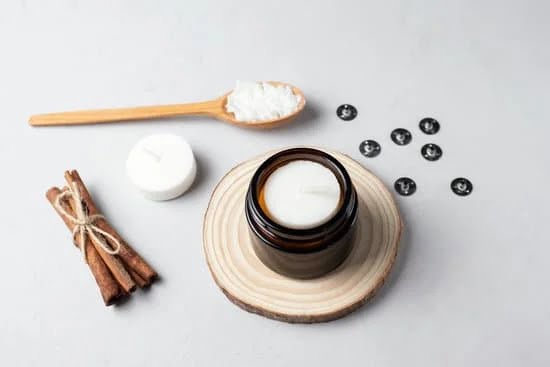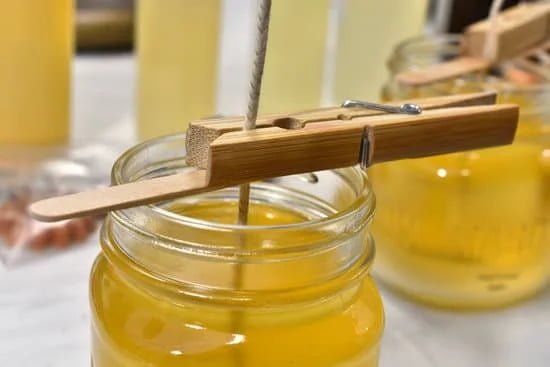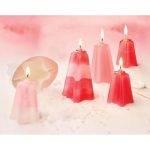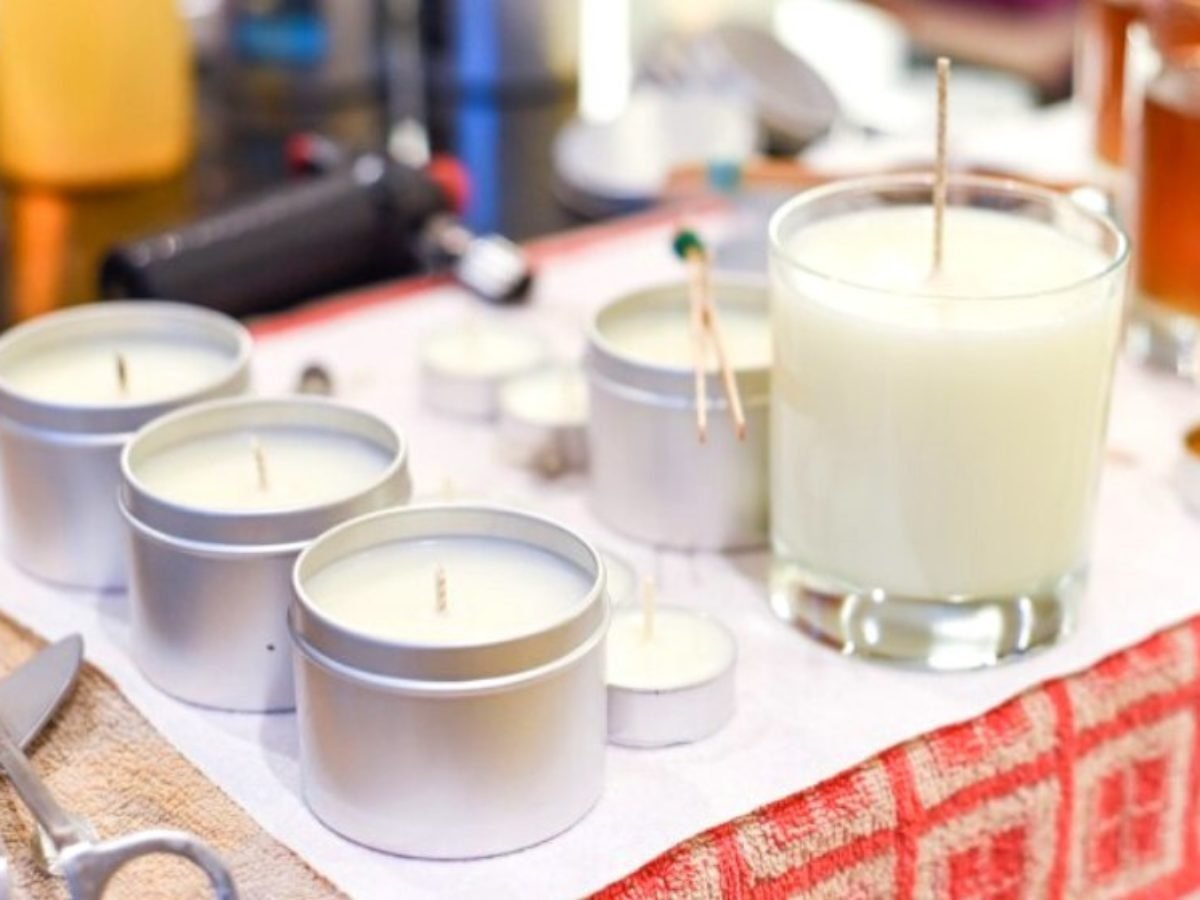Candle making is an art that combines both creativity and science. And when it comes to creating the perfect candle, fragrance plays a crucial role. Fragrances have the power to evoke emotions, memories, and create a soothing ambiance in any space. Whether you are a beginner or an experienced candle maker, understanding the world of fragrances is essential for crafting unique and captivating candles.
In this article, we will explore the diverse range of options available when it comes to fragrances for candle making. From essential oils extracted from nature’s aromatic masterpieces to synthetic fragrance oils offering endless possibilities, there is something for every candle maker’s preference and style. We will delve into the factors you should consider when choosing the right fragrance for your candle, including scent profiles, target audience, and intended purpose.
Furthermore, we will provide inspiration with popular fragrance combinations that can elevate your candle scents to new heights. By combining different fragrances, you can create unique and personalized scents that set your candles apart from the rest. Additionally, we will discuss important safety tips and precautions for handling fragrances in candle making to ensure a safe and enjoyable experience.
So join us as we embark on this olfactory journey through the world of fragrances for candle making. Discover how different scents can transform your candles into artistic masterpieces that not only light up a room but also fill it with enchanting aromas.
Whether you’re looking to experiment with unconventional fragrances or simply preserve the longevity of your favorite scents, this article will provide valuable insights and techniques to help you become a fragrance aficionado in the realm of candle making.
Understanding Fragrances
When it comes to candle making, fragrances play a crucial role in creating the desired ambiance and sensory experience. With countless options available, understanding fragrances is essential to choose the right ones that complement your candle’s purpose and style. Whether you prefer natural or synthetic scents, familiarizing yourself with the different types of fragrances will enable you to make informed choices and create unique combinations.
Essential Oils: Nature’s Aromatic Masterpieces for Candle Making
One popular option for candle fragrances is essential oils. Derived from plants through various extraction methods, essential oils offer a wide range of captivating aromas. From calming lavender to zesty lemon and soothing eucalyptus, these natural aromatic masterpieces are known for their therapeutic properties as well.
When using essential oils in candle making, it is important to consider that they have varying fragrance intensities. Some oils may require a higher concentration to achieve a desired scent level, while others may be more potent and need only a few drops. Additionally, keep in mind that certain essential oils have lower flash points, meaning they evaporate at lower temperatures. To preserve their fragrance, it is recommended to add these oils at lower temperatures during the candle-making process.
Synthetic Fragrance Oils: Unlocking a World of Endless Possibilities
For those looking for an extensive array of fragrance options, synthetic fragrance oils provide endless possibilities. Created by combining various aroma compounds, these oils can mimic the scents of virtually anything – from floral notes like rose and jasmine to sweet aromas like vanilla and chocolate. Synthetic fragrance oils also tend to have longer-lasting scents compared to essential oils.
When choosing synthetic fragrance oils for your candles, it is important to ensure that they are designed specifically for candle making. Some fragrances may not perform well in candles due to their composition or volatility. It is recommended to carefully read product descriptions and reviews, as well as conducting small test batches, to ensure the fragrance oil works effectively and produces the desired scent throw in your candles.
Custom Fragrance Blends: Unleashing Your Creativity
In addition to essential oils and synthetic fragrance oils, another exciting option for candle makers is creating custom fragrance blends. This involves combining multiple scents to create a unique aroma that reflects your creativity and personal style. By experimenting with different combinations of essential oils, synthetic fragrance oils, or even mixing both together, you can craft signature fragrances that set your candles apart.
To create custom fragrance blends, start by selecting complementary scents that blend harmoniously together. Some popular combinations include floral and citrus notes for a refreshing aroma or woody and spicy elements for a warm and inviting vibe.
Remember to keep track of the measurements used in each blend to recreate the mixture accurately in future batches. With custom fragrance blends, you have the opportunity to truly express your artistic vision and produce distinct candle scents that resonate with your customers or enhance your personal space.
Understanding fragrances opens up a world of creative possibilities for candle making. By exploring the diverse range of options available – from natural essential oils to versatile synthetic fragrance oils – you can mix and match captivating scents that transform your candles into sensory delights.
Additionally, creating custom fragrance blends allows you to unleash your creativity and produce one-of-a-kind aromas that make your candles truly remarkable. So whether you prefer classic scents or want to push boundaries with unconventional fragrances, understanding fragrances will help you make informed decisions while embarking on your candle-making journey.
Essential Oils
When it comes to creating exquisite and alluring scents for your candles, essential oils are the go-to choice for many candle makers. Derived from various plants, these oils capture the true essence of nature and offer a wide range of benefits beyond their delightful fragrances. Whether you prefer floral, citrus, or herbal scents, essential oils provide endless possibilities for creating unique and captivating candle aromas.
One of the main advantages of using essential oils in candle making is their natural and pure composition. Unlike synthetic fragrance oils, essential oils are extracted directly from plants through methods such as steam distillation or cold pressing. This means that they retain the natural properties and aromas of the plants they come from, providing a more authentic and organic experience when used in candles.
Furthermore, essential oils offer numerous therapeutic benefits that can enhance your overall well-being. Certain oils have known calming properties like lavender or chamomile, while others can invigorate your senses and boost your mood like peppermint or citrus oils. By incorporating these beneficial qualities into your candles, you create a multi-sensory experience that not only looks beautiful but also provides wellness benefits.
| Essential Oil | Main Scent Profile |
|---|---|
| Lavender | Floral, calming |
| Orange | Citrusy, uplifting |
| Patchouli | Earthy, exotic |
| Peppermint | Minty, refreshing |
| Sandalwood | Woody, warm |
| Lemon Eucalyptus | Fruity, invigorating |
These are just a few examples of the wide array of essential oils available for candle making. Exploring different combinations and experimenting with ratios can lead to exquisite creations that cater to various preferences and moods. Remember to always source high-quality and pure essential oils from reputable suppliers to ensure the best results in your candle-making journey.
Synthetic Fragrance Oils
When it comes to creating unique scents for candles, synthetic fragrance oils offer candle makers a vast array of options and endless possibilities. These laboratory-made fragrances are designed to mimic natural scents or even create entirely new ones. With their versatility and affordability, synthetic fragrance oils have become increasingly popular in the world of candle making.
One of the advantages of using synthetic fragrance oils is the wide range of scents available. Whether you’re looking for traditional floral notes like rose or lavender, refreshing citrusy aromas, warm and cozy vanilla scents, or even unconventional fragrances like fresh laundry or campfire smoke, there is likely a synthetic fragrance oil that can help you achieve your desired scent profile.
Additionally, synthetic fragrance oils often have a stronger and longer-lasting scent compared to essential oils. This means that candles made with synthetic fragrance oils will fill a room with their aroma more quickly and continue to release their scent for longer periods of time. Candle makers can choose from different levels of fragrance intensity depending on their personal preferences or the desired strength for their specific candle product.
Here are some popular synthetic fragrance oil options commonly used in candle making:
– Fruity scents: Synthetic fragrances can replicate the smells of various fruits such as apples, berries, citrus fruits, and tropical fruits. These vibrant and refreshing scents are perfect for adding a burst of energy to your candles.
– Floral scents: From classic favorites like rose and jasmine to unique blends like gardenia and magnolia, synthetic fragrances can capture the essence of flowers. These elegant and romantic scents can add a touch of beauty to any candle.
– Gourmand scents: Synthetic fragrance oils can recreate mouthwatering aromas like chocolate, caramel, coffee, vanilla, and spices. These cozy and comforting scents are perfect for creating candles that invoke feelings of warmth and indulgence.
– Fresh scents: If you prefer clean and crisp scents, synthetic fragrance oils can offer options like linen, sea breeze, freshly cut grass, or rain. These invigorating and rejuvenating fragrances can bring a breath of fresh air into any space.
It’s important to note that while synthetic fragrance oils offer a wide range of possibilities, some candle makers may have personal preferences for natural ingredients or customers with sensitivities to synthetic fragrances. In such cases, it’s recommended to consider using essential oils or exploring other natural fragrance options.
Choosing the Right Fragrance for Your Candle
When it comes to choosing the right fragrance for your candle, there are a few factors to consider. The scent of a candle is one of its most important qualities, as it sets the mood and creates an inviting atmosphere in any space. Here are some key factors to keep in mind when selecting fragrances for candle making:
Purpose
Consider the purpose of your candle and the mood you want to create. Are you looking for a relaxing ambiance or an energizing atmosphere? Different fragrance families can evoke specific emotions and sensations. For example, lavender is known for its calming properties, while citrus scents like lemon or grapefruit can be refreshing and invigorating.
Target Audience
Think about who will be using or enjoying your candles. Fragrance preferences can vary greatly from person to person, so consider the preferences and tastes of your target audience. If you’re creating candles for a specific event or occasion, such as a wedding or baby shower, choose scents that are universally pleasing and not overpowering.
Candle Type
The type of candle you’re making can also influence your fragrance choice. Some fragrances perform better in certain candle types due to their composition or flashpoint (the temperature at which they give off flammable vapors). For example, soy wax candles tend to work well with essential oils because they have a lower flashpoint than synthetic fragrance oils.
Personal Preferences
Lastly, trust your own personal preferences when choosing fragrances for candle making. What scents do you find appealing? What aromas bring you joy or comfort? Don’t forget that creating candles is also an opportunity for self-expression and creativity.
By considering these factors, you can select the perfect fragrance that aligns with your vision for the candle and meets the expectations of those who will enjoy it. Choosing the right scent is a crucial step in creating a candle that not only looks beautiful but also fills any space with an enchanting aroma.
Popular Fragrance Combinations
When it comes to creating candles with unique and captivating scents, the possibilities are endless. By experimenting with different fragrance combinations, you can create truly one-of-a-kind aromas that will make your candles stand out. Here are some popular fragrance combinations that can inspire you to create amazing candle scents:
- Floral Delight: Combine the delicate and sweet scent of rose with the fresh and uplifting aroma of lavender. This combination creates a harmonious blend that is perfect for creating a calming and soothing atmosphere in any space.
- Citrus Burst: For a refreshing and energizing scent, combine zesty lemon with tangy orange. This combination is invigorating and will instantly uplift the mood in any room.
- Woodsy Serenity: Create a tranquil ambiance by combining earthy scents like sandalwood and cedarwood. This combination evokes a sense of grounding and peace, making it ideal for meditation or relaxation.
- Fruity Fusion: Combine fruity scents like juicy berries and tropical pineapple for a fun and vibrant aroma. This combination is perfect for creating a lively and cheerful atmosphere in your space.
- Spicy Warmth: Blend warm spices like cinnamon and nutmeg for a cozy and inviting scent. This combination is perfect for creating a comforting ambiance during the colder months or for adding a touch of warmth to any space.
To create these fragrance combinations, simply mix the corresponding essential oils or synthetic fragrance oils together in the desired proportions based on your preferences. It’s important to note that experimentation is key when creating unique candle scents, so don’t be afraid to try different combinations until you find the perfect one.
Remember to take into consideration the base notes, middle notes, and top notes of each fragrance when combining them. This will help ensure that all the elements of the fragrance come together harmoniously to create a well-balanced scent.
By using popular fragrance combinations as inspiration, you can unleash your creativity and create candles with scents that are truly unique and captivating. Whether you’re making candles as a hobby or for business, exploring different fragrance combinations will allow you to create artistic masterpieces that delight the senses and leave a lasting impression.
Fragrance Safety
When it comes to handling fragrances in candle making, it is important to prioritize safety. Working with fragrances involves handling potentially volatile substances, so taking precautions is essential. Here are some tips and guidelines to ensure a safe and enjoyable candle making experience:
- Use protective gear: When working with fragrance oils, it is advisable to wear gloves and safety goggles to protect your skin and eyes. Some fragrance oils can cause allergic reactions or irritation upon contact. By wearing protective gear, you can minimize the risk of any adverse effects.
- Work in a well-ventilated area: Adequate ventilation is crucial when working with fragrances as they often contain volatile compounds that can be harmful if inhaled excessively over time. Make sure you have good airflow in your workspace by opening windows or using fans to circulate the air.
- Follow manufacturer’s guidelines: Different fragrances may have specific recommendations or guidelines provided by the manufacturer. Always read and follow these instructions carefully, including any recommended usage percentages or temperatures for adding fragrances to wax.
| Type of Fragrance Oil | Precautions |
|---|---|
| Natural Essential Oils | Some essential oils are phototoxic and may cause skin sensitivity when exposed to sunlight. It is important to check the safety information for each oil before use. |
| Synthetic Fragrance Oils | Some synthetic fragrance oils may contain components that are not suitable for certain candle-making techniques such as gel candles or soy wax candles. Always make sure to check the compatibility of fragrance oils with your chosen candle-making method. |
By following these safety tips and precautions, you can ensure a safe and enjoyable experience when working with fragrances in candle making. Prioritizing safety not only protects yourself but also allows you to fully enjoy the creative process of crafting beautiful scented candles.
Fragrance Intensity
Understanding Fragrance Intensity
One of the key factors in creating the perfect scented candle is getting the fragrance intensity just right. The intensity refers to how strong or pronounced the scent is when the candle is burned. Some people prefer a subtle and mild fragrance, while others enjoy a more intense and powerful aroma. Understanding fragrance intensity is crucial in order to achieve the desired effect for your candles.
Factors Affecting Fragrance Intensity
Several factors can affect the intensity of a scented candle’s fragrance. One important factor is the type and concentration of fragrance oil used. Essential oils are generally more concentrated than synthetic fragrance oils, so they often provide a stronger scent when used in candle making.
Additionally, the amount of fragrance oil you use in your candle wax can also impact its intensity. It’s important to follow recommended guidelines and ratios provided by fragrance suppliers to ensure proper usage and avoid overwhelming or weak scents.
The size and composition of the candle can also influence fragrance intensity. Smaller candles tend to have a more concentrated scent because there is less volume for the scent to disperse throughout. On the other hand, larger candles may need a higher concentration of fragrance oil to ensure that the scent fills up a larger space effectively.
Controlling Fragrance Intensity
Fortunately, there are several strategies you can employ to control and adjust the fragrance intensity of your candles. If you find that your candle has too strong of a scent, you can try reducing the amount of fragrance oil used in your next batch or opt for a milder scent altogether. On the other hand, if you feel that your candle scent is not strong enough, you can increase either the concentration or quantity of fragrance oil.
It’s also important to consider how different fragrances interact with each other when creating unique combinations. Some fragrances may naturally have a stronger or weaker scent, so experimenting with different combinations can help you achieve the desired fragrance intensity. Additionally, using different wicks can also impact how quickly the fragrance is released and therefore affect the overall intensity of your scented candle.
Fragrance Fixation
When it comes to candle making, one of the key factors that determines the success and satisfaction of your final product is the longevity of the fragrance. After all, what good is a beautifully scented candle if the aroma disappears after just a few hours? In this section, we will explore techniques that can help ensure your candle’s fragrance lasts long, allowing you and those around you to enjoy its delightful scent for an extended period of time.
One technique to maximize the longevity of your candle’s fragrance is through proper wick selection. The size and type of wick used in your candle can greatly impact how evenly and slowly it burns, which in turn affects how long the fragrance is released into the air. For optimum fragrance fixation, choosing a wick that matches the diameter of your container or mold is crucial.
A wick that is too small may not produce enough heat to melt the wax evenly, resulting in an uneven burn and shorter scent life. On the other hand, a wick that is too large may cause excessive heat, burning through the wax too quickly and therefore reducing how long the fragrance lingers.
Another technique for extending your candle’s aroma is by curing or aging your candles before burning them. Much like fine wine or cheese, candles can benefit from having some time to sit and “cure” before they are lit. This allows the fragrance oils to fully bond with the wax, resulting in a more robust and longer-lasting scent throw when burned.
To properly cure your candles, simply store them in a cool, dark place for at least two weeks before lighting them up. This simple step can make a significant difference in enhancing fragrance longevity.
Furthermore, using high-quality ingredients can also contribute to longer-lasting fragrances in your candles. Investing in premium-grade wax and fragrance oils can make a noticeable difference in how well your candle holds its scent over time.
Lower-quality waxes may not have the same ability to hold onto fragrance oils, resulting in a weaker and shorter-lived aroma. Similarly, using synthetic fragrance oils that are specifically formulated for candle making can offer superior scent retention compared to those not designed for this purpose.
By implementing these techniques, you can ensure that your candle’s fragrance lasts long, allowing you to fully enjoy the delightful aromas that you have carefully selected. From choosing the right wick to curing your candles before lighting them up, these simple steps can make a significant difference in maximizing the longevity of your candle’s aroma.
So go ahead and create beautiful candles that not only look stunning but continue to fill your space with enchanting scents for hours on end.
| Technique | Description |
|---|---|
| Proper wick selection | Choosing a wick that matches the diameter of your container or mold |
| Curing or aging | Storing candles in a cool, dark place for at least two weeks before burning |
| Using high-quality ingredients | Including premium-grade wax and fragrance oils designed for candle making |
Experimentation and Innovation
When it comes to candle making, there is no limit to the creativity and imagination one can bring to the table. While traditional scents such as lavender, vanilla, and citrus are always popular choices, pushing the boundaries and experimenting with unconventional fragrances can lead to truly unique and captivating candle scents. By thinking outside of the box and exploring unconventional fragrance options, candle makers can create artistic masterpieces that stand out from the crowd.
Exploring Unconventional Fragrance Options
The beauty of working with fragrances for candle making is that there is a wide variety of scents available to choose from. To push the boundaries and create unconventional candles, consider exploring some lesser-known or unexpected fragrance options. For example, try incorporating savory scents such as bacon or fresh herbs like rosemary into your candles for a unique twist.
Other unconventional scents could include leather, earthy moss, or even exotic spices like cardamom or saffron. Experimenting with these unexpected fragrances can result in candles that appeal to niche markets or become a talking point among customers.
Blending Fragrances: Creating Your Signature Scent
Another way to push the boundaries with unconventional candle fragrances is by experimenting with blending different scents together. This allows you to create your own signature scent that is truly one-of-a-kind.
Combining two or more unexpected fragrances can result in captivating aromas that are both intriguing and alluring. For example, blending coffee and bergamot may produce an invigorating scent perfect for waking up on a cold morning, while mixing patchouli and lime may create a refreshing aroma ideal for relaxation.
Market Research: Niche Trends and Consumer Preferences
Before diving headfirst into creating unconventional candle fragrances, it is important to conduct market research and understand consumer preferences. Niche trends can provide valuable insights into which unconventional fragrances are gaining popularity and have the potential for success.
Keeping an eye on industry publications, social media platforms, and attending trade shows or craft fairs can help you stay informed about emerging fragrance trends. Additionally, engaging with customers through surveys or online communities can provide direct feedback on their preferences and help guide your experimentation with unconventional fragrances.
By pushing the boundaries with unconventional candle fragrances, candle makers have the opportunity to create truly unique and memorable products. Whether it is by exploring unusual scents, blending different fragrances together, or following niche trends, experimenting and innovating in this way allows for artistic expression and the creation of candles that stand out from the competition. With a little creativity and a lot of imagination, candle makers can transform their craft into an extraordinary sensory experience for customers.
Fragrance Storage and Preservation
The longevity and quality of fragrances are crucial factors in candle making. Proper storage and preservation techniques can help maximize the shelf life of your fragrances, ensuring that they maintain their potency and aroma over time. Here are some tips to help you store and preserve your fragrances effectively.
Firstly, it is essential to store your fragrances in a cool, dark, and dry place away from direct sunlight or heat sources. Exposure to these elements can cause the fragrance oils to degrade or lose their scent more quickly. A cool area such as a basement or cupboard is ideal for storing your fragrances.
Secondly, it is important to keep your fragrance bottles tightly sealed when not in use. Oxygen exposure can lead to oxidation and evaporation, which can negatively affect the fragrance’s quality and longevity. Make sure that the caps or lids are securely fastened after each use to prevent air from entering the bottle.
Furthermore, consider using dark or opaque glass bottles for storing your fragrances. These types of containers can provide an additional layer of protection against light-induced degradation. Avoid using plastic containers, as they may react with the fragrance oils over time.
In addition to proper storage techniques, you can also extend the shelf life of your fragrances by employing some preservation measures. One effective method is to transfer larger quantities of fragrance oils into smaller bottles or vials. By reducing the amount of air space within each container, you minimize contact with oxygen, slowing down oxidation processes.
Another preservation technique is keeping your fragrance oils at consistently low temperatures. You may consider refrigerating them in a dedicated space if possible. However, it is important to note that some essential oils may solidify at low temperatures, so be cautious when using this method for certain fragrances.
By implementing these storage practices and preservation methods, you can ensure that your fragrance collection remains fresh and potent for an extended period. Taking care of your fragrances not only maximizes their shelf life, but it also allows you to create consistently high-quality and aromatic candles.
Conclusion
In conclusion, the world of fragrances for candle making offers endless possibilities for creating artistic masterpieces. By understanding the diverse range of options available, including essential oils and synthetic fragrance oils, candle makers can unlock their creativity and experiment with unique scent combinations. It is important to consider factors such as customer preferences and the intended use of the candle when choosing the right fragrance.
To ensure safety when handling fragrances, it is recommended to follow tips and precautions such as wearing protective gear and properly labeling fragrance bottles. Achieving the desired intensity of fragrance in a scented candle takes practice and experimenting with different concentrations, while techniques like using fixatives can help prolong the lifespan of the aroma.
For those looking to push boundaries and explore unconventional fragrances, there is room for experimentation and innovation in candle making. Whether it’s infusing candles with unexpected scents from herbs or spices or blending contrasting aromas together, the possibilities are limited only by one’s imagination.
Lastly, proper storage and preservation techniques can maximize the shelf life of fragrances, ensuring they remain fresh for future projects. By storing them in a cool and dark place, away from sunlight or air exposure, candle makers can continue to use their favorite aromas for years to come.
In summary, fragrances play a vital role in creating captivating candles that not only provide light but also fill a room with delightful scents. With an understanding of different fragrance options and careful consideration of important factors such as safety and intensity, candle makers can elevate their craft to new artistic heights.

Welcome to my candle making blog! In this blog, I will be sharing my tips and tricks for making candles. I will also be sharing some of my favorite recipes.





